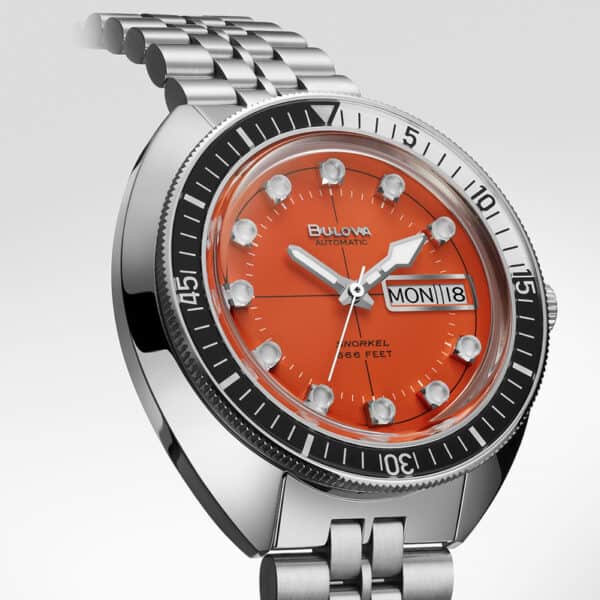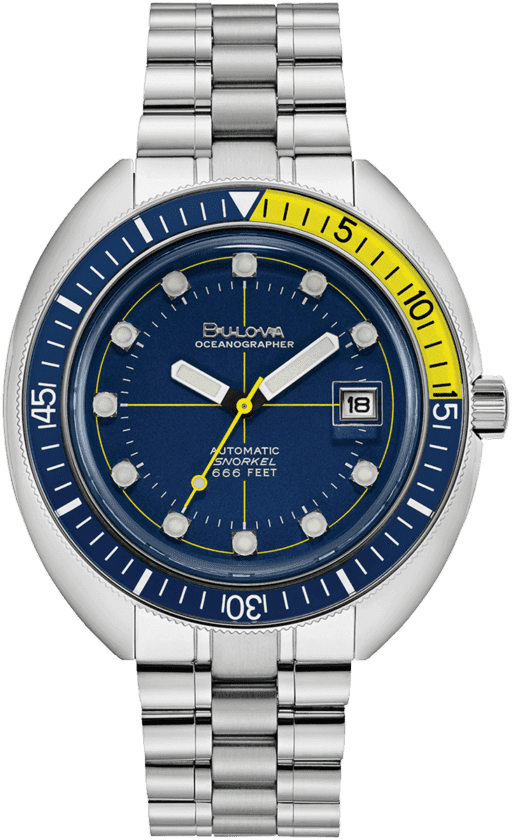History Has It: Bulova - Celebrating its heritage
Although the brand Bulova needs no introduction, I think it is just appropriate to summarize its history as the Bulova Oceanographer celebrates its heritage. Founded in 1875 by Joseph Bulova, an immigrant to the USA of Bohemian origin (in present-day Czech Republic) with their first base of operations in Woodside, New York, Bulova's inception coincided in time with the beginning of a golden age for the North American industry and the general development of the country.
Driven by the pervasive risk-taking spirit of that particular era and the entrepreneurial spirit of the founder, the brand introduced one innovation after another. By the 1920s, after opening a highly mechanised plant in Biel, Switzerland, dedicated to mass-producing watches, Bulova had established itself as one of the world's leading watch brands and by the 1930's and 1940's, its rectangular and curved watches, to fit better on the wrist, were ubiquitous.
Throughout this expansion, another aspect distinguished the brand: apart from innovating, it was clear that Bulova had a keen eye for marketing.Their exploits include the first radio broadcast in 1926 of an "advertisement" for watches, sponsoring the time signal for years: "At the tone, it’s eight o’clock, Bulova Watch Time." In 1926, Ardé Bulova, son of Joseph Bulova, offered a prize of $ 1,000 to the first pilot to fly nonstop across the Atlantic Ocean, which was won in 1927, by the pilot, Charles Lindbergh. This in turn also lead to the launch of a line of commemorative watches under the name "Lone Eagle”.

Like many other renowned brands, Bulova played an important role during the Second World War, as a supplier of military watches (the A-11) to the troops, but also in many other areas.
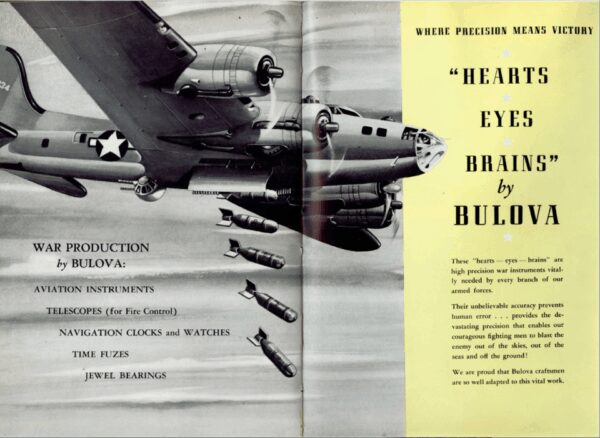
After the great war, Bulova did however adapt to the new times. From the 1940s (and until the late 1970s), the brand occupied a very special place on numerous basketball and ice hockey courts, supplying the counters for these courts.
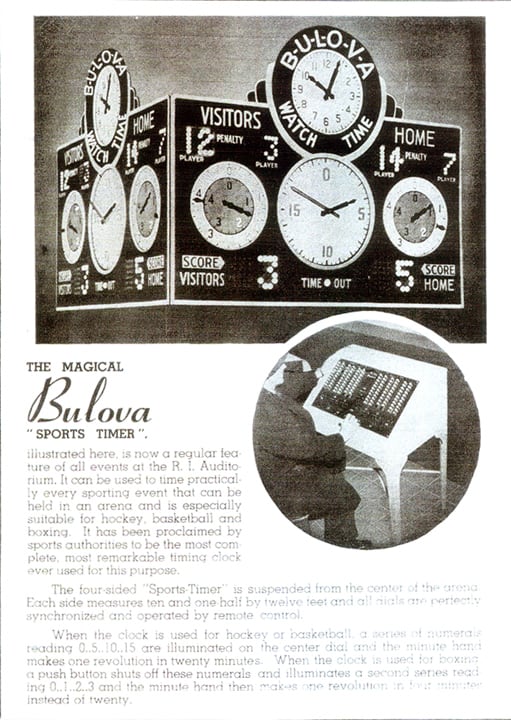
Bulova also established sponsorship relationships with several airlines, such as American Airlines and Pan American Airlines and even appeared in films. One that does come to mind is the Bulova Regatta that was seen in Sir Roger Moore's movie - "The Saint". 1960, then saw the introduction of the famous Bulova Accutron. An abbreviation for “ACCUracy through ElecTRONic”, this watch featured the first tuning fork gauge, revolutionising the industry.
Although its place in horological history was short-lived, when it was superseded by quartz takeover in the 70's, this technology would be used in 46 space missions, specifically as a cockpit clock in the excursion module of the Gemini missions. Continuing with the space race, I imagine that many of you will already know the space trip in 1971 of a Bulova chronograph aboard the Apollo 15 mission, on the wrist of Commander David Scott.

1961 marked the Bulova's entry into the recreational diver's watch market. He introduced two quite typical models of the time: the "Snorkel" (a skin diver) and the "Oversized Super Compressor" in a box from Ervin Piquerez SA. We can see both copies below.
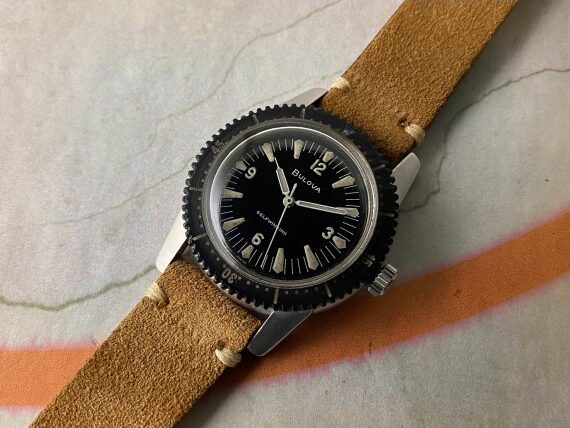
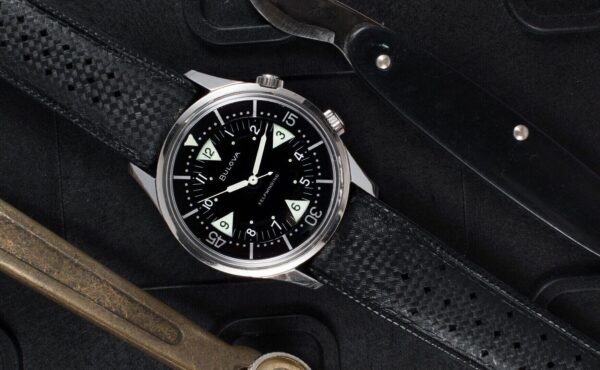
In 1968, Bulova adopted a cushion case for the “Snorkel”, also adding a fine cross hair on the dial and the distinctive three-dimensional markers with tritium. The bezel was made of acrylic resin with a two-color design.
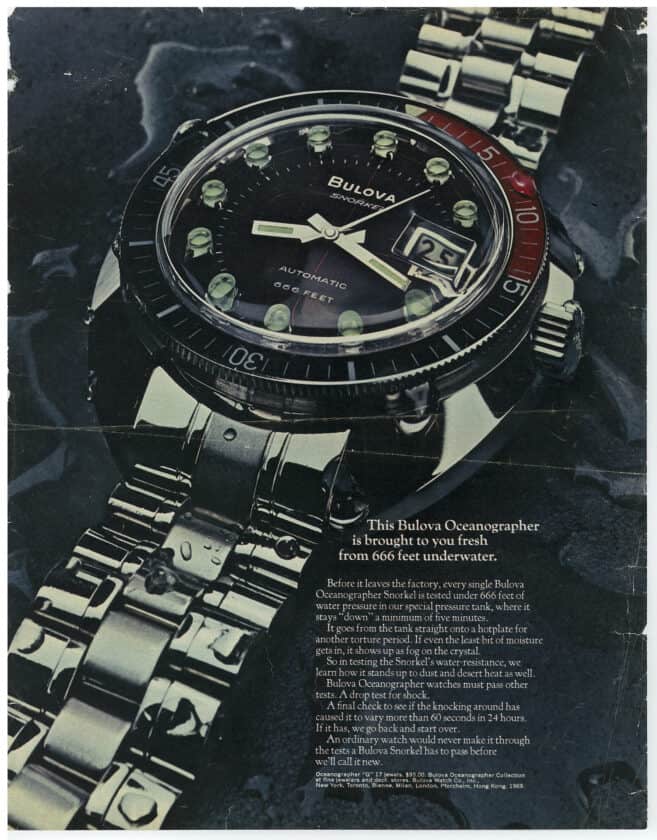
A year later, this line would adopt the name "Oceanographer". In 1972, an orange version of the Bulova Oceanographer debuted, the watch that inspires our protagonist today. Like many other brands, the quartz crisis took its toll on Bulova and it was forced to sell its Swiss subsidiary "Universal Perret Frères SA" in 1977 and close the factory in Biel in 1983. However, thanks to various financial engineering operations, they did managed to survive and finally, on January 10, 2008, Bulova was acquired by the Japanese giant - Citizen.
Oceanographer “Devil Diver”
The nickname "Devil Diver" for this line of watches refers to the 666 feet (200 m) of water resistance offered by the Oceanographer. Bulova reissued (as part of their “Archive Series”) the 1968 “Snorkel” in 2018, releasing a version that was very faithful to the 1972 orange model we saw above. Listed below is this limited edition (666 units) that was powered by a Sellita SW200 caliber and that had a width of 40 mm, faithful to the original.
Along with the limited edition, Bulova also launched a version with a black dial and a larger “Coke” bezel (44mm) with a Japanese caliber (Miyota). This model recovered the nomenclature "Oceanographer". Since then, three color variations have been added to the model, all initially part of the permanent collection.
Early this year, Bulova also added another orange version of the watch to the permanent collection. Differing from the limited edition of 2018 with its black and orange bezel and the rubber strap this reference, 96B350, is also included within the "Oceanographer" line. It is a millimeter wider than the limited version and the original watch, but is obviously a dimension more in line with current trends than the 44 mm of the other four references.
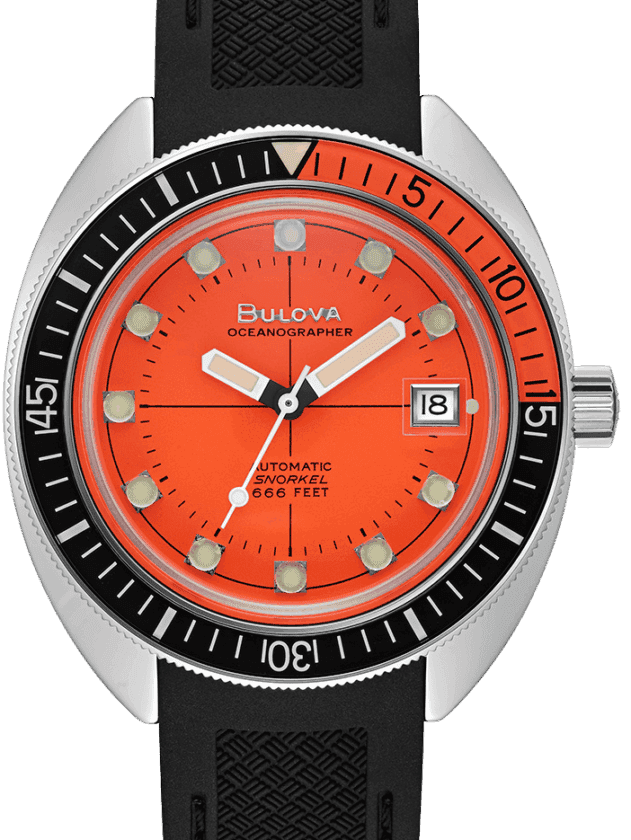
Archival reissues, so fashionable in recent times, are often mere reinterpretations. That however is not the case with this "Oceanographer". While the 44mm versions could be qualified as reinterpretations, this reference definitely tries to faithfully reproduce the vintage watch.
The stainless steel case is fully polished, just like the original watch. As I mentioned earlier, with the added one mm to the width (now 41mm) and another mm to the thickness (14.5mm), the 45mm lug-to-lug length is still very restrained by the type of cushion it uses, allowing it to accommodate many wrist sizes. It has total of 20 mm between lugs.
Although I have not had the opportunity to see an original watch up close, images I have studied suggest that this case is somewhat more emphatic than the one from the 70s. It does not appear to have the same "curves" that clearly distinguished the original watch. So although the sides are thicker, appearing to be less refined, these new references are certainly more contemporary. I think the end result has been a success. All the design cues here evoke the 70s.The double domed sapphire (“box crystal”) offers the attractive “retro” distortions that are so popular, while the orange “traffic cone” on the dial takes us back to the 1972 watch that inspires it.
The “coin edge” bezel feels robust and substantial and that glossy acrylic insert adds a certain retro sensation to the watch. It is bicolor, with a dive scale on a black and orange background (for the last 15 minutes of diving). Even the magnifier above the date window at 3 o'clock does not clash and does its job perfectly.
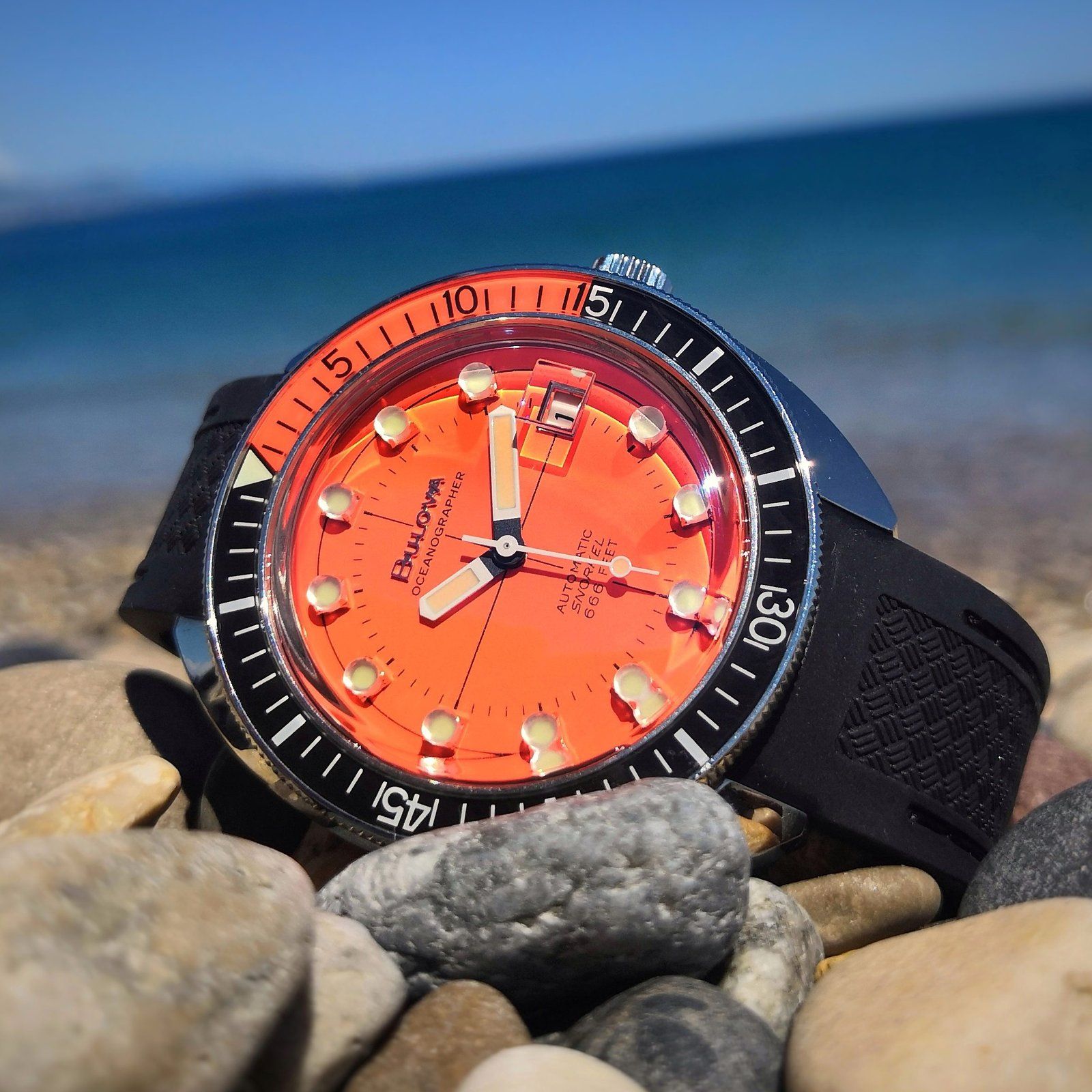
https://www.instagram.com/p/CS33GkDrfb7/
A simple and functional screw-down crown, together with a screw-down blind caseback, gives this watch a water resistance of 200m, in this case ISO certified. That is to say, no matter how much of a reissue it may be, in terms of the aesthetics, this watch is a serious diver.
The dial too is unmistakable. The striking bright orange hue draws you in. A bit of the same goes for the prominent applied markers. They are miniaturised glass cylinders filled with luminescent material, framed by metal rings. The Bulova logo applied at 12 o'clock and the cross hair motif are preserved from the original 1970s watch, as does the text “666 Feet” at 6 o'clock. Another retro touch here is the word “SNORKEL” that is printed in italics. The hands represent a departure from the original watch, although it is also true that they emulate that of the first black “Oceanographer” of 1969. Needless to say, the lume is predictably extraordinary.

Being a brand of the Citizen group and with a view to maintaining an accessible price range, the watch is equipped with the Miyota 821D automatic caliber, in turn a variant of the 821A. Although it is robust and reliable, it is still a basic caliber. That being said, the absence of the hacking seconds and its slower 21,600 vph (3 Hz) beat per rate also resonates with the 70's. The caliber features 21 jewels and offers a 42-hour power reserve with an accuracy is -20 to +40 seconds per day.
This "Devil Diver" comes equipped with a black rubber strap made of polyurethane with curved ends. It hugs the case perfectly and offers a cross hatch texture that is very well executed. Below, you can see it on my modest-sized wrist, confirming that almost every wrist will be able to carry it off. In addition to being flashy and fun this Oceanographer “Devil Diver” offers just the right functions to make it perfectly suitable for your diving escapades. The combination is quite tempting, in my opinion.

The Oceanographer “Devil Diver” priced at approximately € 512 (taxes not included), in my opinion is quite an attractive option for a divers watch, that may not be commercially famous but certainly is a bang for your buck!
No articles found

